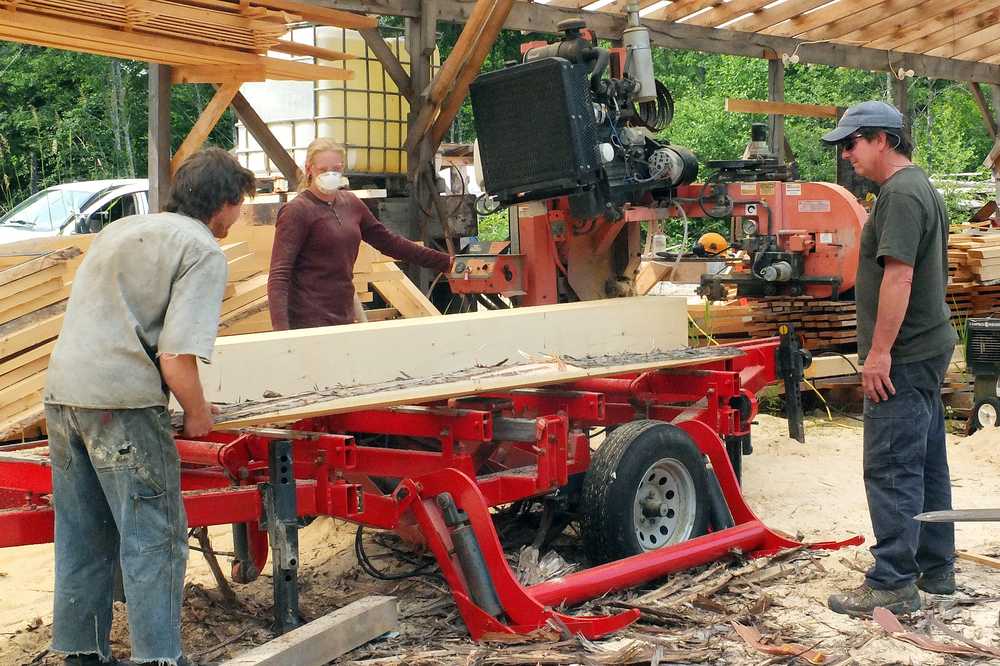TENAKEE SPRINGS, Alaska — For Gordon Chew of Tenakee Logging Company Management, everything is connected.
The trees he and his son, Sterling, 24, selectively harvest from Corner Bay, across the inlet from Tenakee Springs, are connected to homes and jobs in town.
The jobs in Tenakee are connected to the people that hold them. The people that hold them are connected to their families, their families are connected to Tenakee’s school, and Tenakee’s school is connected to the well-being of the community — which is, in turn, connected to America’s rebound from the recession.
Then there’s the fact that TLC’s lumber is sustainably harvested. “Sustainable” is a word Gordon Chew uses a lot.
The Chews moved to Tenakee Springs in 1999 after a maritime visit to Alaska in 1995.
“At the end of the summer, it broke our hearts to try and leave,” Gordon said.
“The only time I’ve ever been depressed in my life was having to leave Alaska.”
Once the family arrived in Tenakee four years later, Gordon, a skilled carpenter and shipwright, worked for the city and doing general construction.
“We were paying a fortune to import lumber,” Gordon said. “It was time consuming and expensive. It took a lot of planning.”
So they decided to see about logging and milling on their own. In 2002, they bought a lumber mill from a fellow Tenakee resident; they had a one-ton wrecker they used to drag trees into place. They were awarded their first contract by the U.S. Forest Service in 2007. Now, the Chews have two lumber mills and have gradually accumulated the heavy equipment that helps in the lumber trade.
The local milling operation, Gordon said, “works in well with a lot of our core values. Local products, local jobs, using wood locally — not exporting anything.”
Environmental groups agree. The Southeast Alaska Conservation Council in 2011 profiled TLC as part of its “Buy Local: Alaskan Wood, Alaskan Jobs” campaign.
When the Chews find trees they’re interested in harvesting, the Forest Service goes through a National Environmental Protection Act process to okay the trees for sale. They design a sale and put it up for public bidding. So far, TLC has won all of the bids it’s wanted — they tend to be small. One, for example, was for 35 trees that provided about 2,000 board feet each, on average.
“Even if we were offered clear cuts, we would not accept them,” Gordon said. “There’s nothing good about clear cuts, as far as the environment goes.”
Gordon said the company has a “great relationship with the federal government.”
“I’m especially fond of the federal government right now, because they’ve been supportive of my business,” he said, referring to the U.S. Forest Service.
Chris Budke, North Zone Timber Management Assistant for the Forest Service, acts as a liaison to TLC and other small mills around Sitka, Hoonah, Yakutat, Admiralty Island and Juneau.
“Our goal is to keep these guys in business,” Budke said. “To supply them with logs, so that they can continue to make logs, boards, a business. That’s our goal, is to keep them viable with existing roads and the existing timber base.”
Selective harvests, the Chews say, work with the forest’s ecosystem. Some of the older trees they harvest are already starting to die, and removing them opens up light for the seedlings.
“When you have more light down on the forest floor, stuff happens down there,” Gordon said.
“Now there’s a bunch of new ones (trees) growing already,” Sterling said, referring to a recent harvest. “In a matter of days, you can see them just start exploding.”
The timber in Southeast Alaska is slow-growing, meaning it’s stronger, he said. It’s also perfect for traditional art forms, and one of the Chews biggest customers, he said, is Tripp’s Mount Juneau Trading Post. Artists use TLC wood to make paddles, he said.
“People always separate the timber industry from tourism… But our biggest customer sells to tourists every day,” Gordon said. “And it’s really fun to make something that’s not going to get walked on — that will hang on a wall for 100 years.”
Just the same, they never know what they’re going to get out of a tree until they open it up. One defect — like a large knot — can render a board unfit for building.
“That’s probably one of our biggest dilemmas, is what to do with all the lumber that we make, because you don’t always get what you’re hoping for,” Gordon said.
The Chews are in the middle of what Gordon calls “the biggest year of my life” — a multimillion dollar restoration of and addition to Tenakee’s historic Snyder Mercantile Building, which was built at the end of the 1800s.
Just the same, they have big goals for the future.
Sterling’s main goal is to end the company’s dependence on fossil fuels. “That’s the biggest thing for me,” he said, mentioning cost, health effects and sustainability. “Being completely dependent on diesel is what scares me about taking it over.”
The end goal? Products that have been dried and finished right in Corner Bay, Sterling said.
“With a good kiln and moulder, we’d be able to make some really cool stuff,” he said. “We’re just kind of skimming the surface right now, I feel like.”
A kiln — which dries wood so that it’s better fitted for a variety of construction jobs — could be a way for them to use their “mountains of sawdust.” A moulder shapes wood.
Sterling is also passionate about boat building, which he does through Connelly Boatworks (Connelly is his mother’s last name.)
“It’s fun to see it (the business) grow from nothing to now,” Sterling said. “There’s something about turning trees into wood, and seeing it around town.”
“I’m an environmentalist logger,” Gordon said. “Sounds like an oxymoron.”

